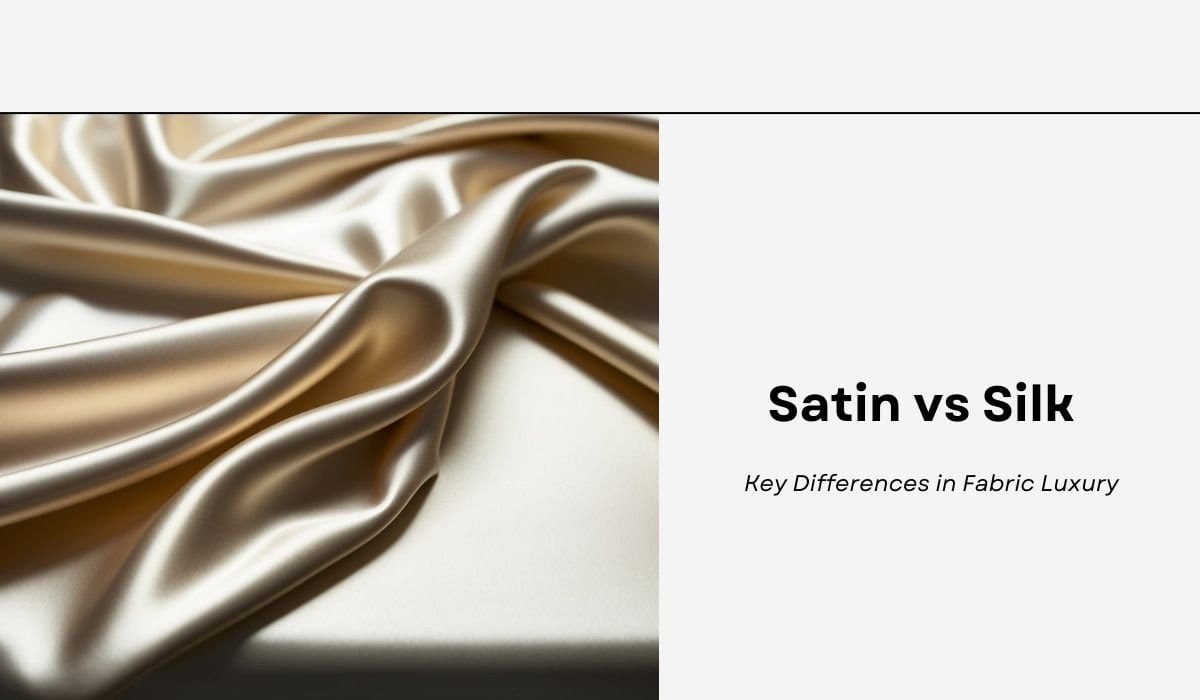A Detailed Comparison of Two Beloved Luxury Fabrics: Understanding Their Unique Properties, Benefits, and Best Uses
Satin and silk are two fabrics that often get confused due to their similar appearance and luxurious feel. While they may look alike, they have distinct differences in origin, composition, and properties. Silk is a natural fibre produced by silkworms, while satin is a weave that can be made from various materials, including silk, polyester, or nylon.
Both fabrics are prized for their smooth texture and lustrous sheen, making them popular choices for luxury bedding and high-end fashion. Silk is renowned for its softness, breathability, and temperature-regulating qualities. Satin, on the other hand, offers a similar glossy appearance but can be more affordable and easier to care for, depending on its composition.
When choosing between satin and silk, consider factors such as comfort, durability, maintenance, and budget. Silk tends to be more expensive due to its natural origin and labour-intensive production process. Satin, especially when made from synthetic fibres, can be a more budget-friendly option that still provides a luxurious look and feel.
On This Page
Key Takeaways
- Silk is a natural fibre, while satin is a weave that can be made from various materials
- Both fabrics offer a smooth texture and lustrous appearance, but silk is typically more expensive
- The choice between satin and silk depends on factors like comfort, durability, maintenance, and budget
Understanding Fabrics
Satin and silk are two distinct fabrics with unique properties. Both offer a luxurious look and feel, but they differ in composition, production, and characteristics.
Defining Satin
Satin is a weave pattern rather than a specific material. It can be made from various fibres, including silk, polyester, or nylon. The satin weave creates a smooth, glossy surface on one side and a dull back.
Satin fabric is known for its:
- Lustrous appearance
- Smooth texture
- Durability
- Wrinkle resistance
Satin comes in different weights and can be used for clothing, bedding, and upholstery. It’s often chosen for its elegant drape and sheen. Satin offers accessible luxury, especially in items like pillowcases.
Defining Silk
Silk is a natural fibre produced by silkworms. It’s prized for its softness, sheen, and strength. Silk fabric is made by unravelling the cocoons of silkworms and weaving the long fibres into cloth.
Key features of silk include:
- Naturally lustrous
- Lightweight yet strong
- Excellent breathability
- Temperature-regulating properties
Silk is often used in high-end fashion, lingerie, and bedding. It’s hypoallergenic and kind to skin. However, silk requires more delicate care than many synthetic fabrics. Its natural origins make it biodegradable and sustainable.
Fabric Composition and Weave
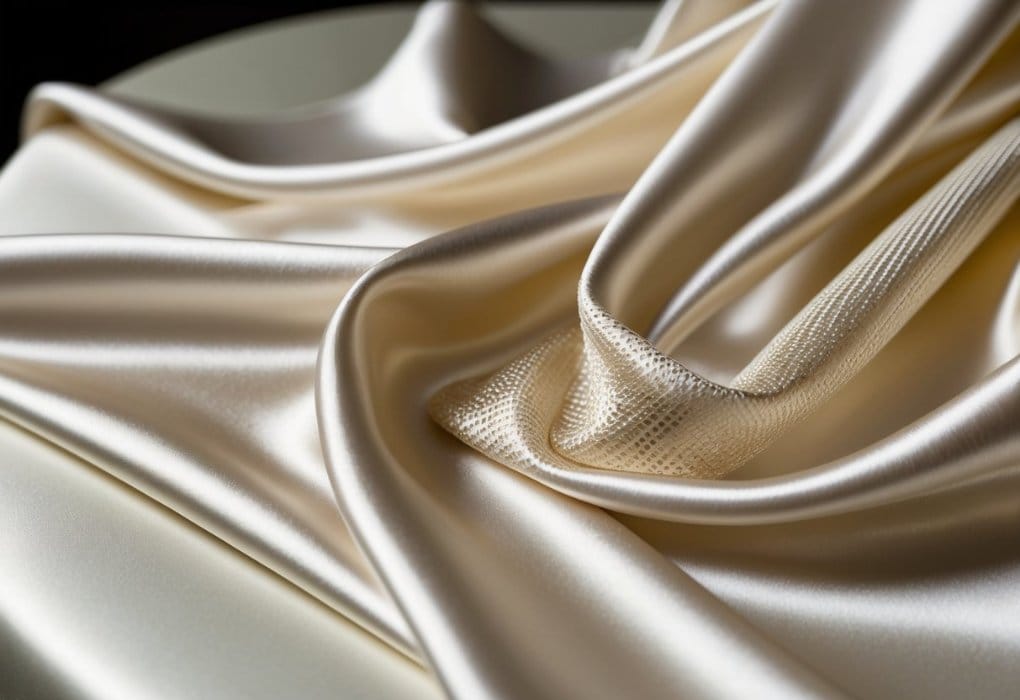
Satin and silk differ in their fabric composition and weaving techniques. Satin refers to a specific weave pattern, while silk is a natural fibre derived from silkworms. These distinctions affect the properties and appearance of each fabric.
Satin Weave Technique
The satin weave creates a smooth, glossy surface on one side of the fabric. This technique involves floating the warp or weft yarns over multiple threads before interlacing. The result is a shiny face and a duller back.
Satin can be made from various fibres, including:
- Silk
- Polyester
- Nylon
- Rayon
The choice of fibre affects the fabric’s characteristics. Polyester satin, for example, is more durable and less expensive than silk satin.
Different types of satin weaves exist:
- 4-harness satin
- 5-harness satin
- 8-harness satin
The number refers to how many warp yarns each filling yarn floats over before interlacing.
Silk Production
Silk is a natural protein fibre produced by silkworms. The production process involves several steps:
- Silkworms feed on mulberry leaves
- They spin cocoons made of a single silk thread
- The cocoons are harvested and boiled to extract the silk filaments
- Multiple filaments are twisted together to form silk yarn
Silk fabric is renowned for its natural protein fibre composition, resulting in a smooth, soft texture. It is highly valued for its lustre, strength, and ability to absorb dyes.
Silk can be woven into various fabric types, including:
- Charmeuse
- Chiffon
- Organza
- Crepe de Chine
Each weave produces a unique texture and appearance, showcasing silk’s versatility as a textile.
Comparing Textural Properties
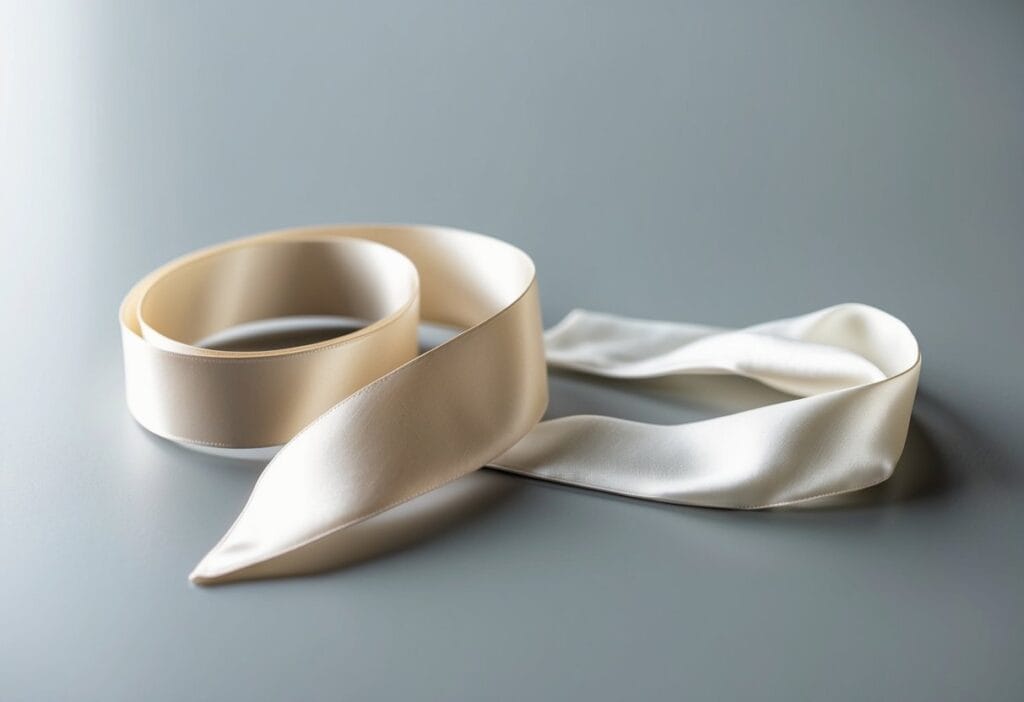
Satin and silk offer distinct tactile experiences. Their unique textures stem from different production methods and materials.
Texture of Satin
Satin has a smooth texture that’s shiny on one side and matte on the other. This is due to its weaving technique, which allows more threads on the fabric’s surface.
Satin feels slick to the touch. It has a glossy finish that reflects light, giving it a luxurious appearance. The fabric drapes well and has a flowing quality.
Despite its smoothness, satin can sometimes feel slightly heavier than silk. It may not be as breathable, which can affect comfort in warm weather.
Texture of Silk
Silk is renowned for its exceptionally smooth texture. It’s soft, lightweight, and has a natural sheen that’s less pronounced than satin’s glossy finish.
The fabric feels cool and slippery to the touch. It’s highly breathable, making it comfortable in various climates. Silk’s texture is consistent on both sides of the fabric.
Silk’s softness is unmatched. It drapes beautifully and has a fluid-like quality when it moves. The natural fibres give it a subtle lustre that enhances its luxurious feel.
Practical Uses and Applications
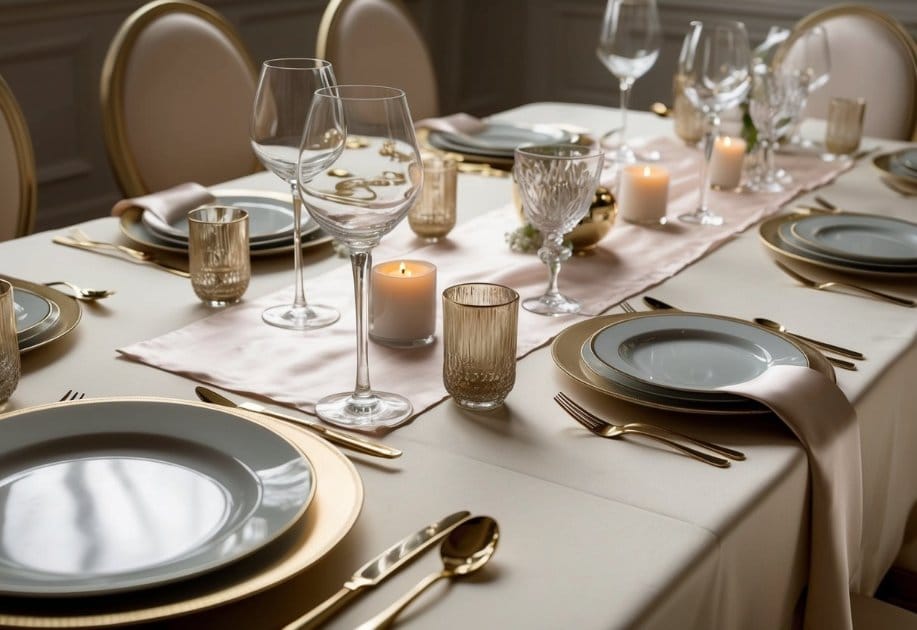
Satin and silk both offer unique qualities that make them suitable for various purposes. Their distinct characteristics lend themselves to different applications in home decor and fashion.
Satin in Home Decor
Satin shines in home decor due to its versatility and affordability. Its smooth texture and lustrous appearance make it a popular choice for bedding and upholstery. Satin sheets provide a luxurious feel without the high cost of silk. They’re easier to care for and more durable, making them practical for everyday use.
In living spaces, satin curtains add elegance and light control. The fabric’s ability to drape well makes it ideal for creating flowing window treatments. Satin pillowcases are also common, offering a smooth surface that’s gentle on hair and skin.
For special occasions, satin tablecloths and napkins bring a touch of sophistication to dining areas. The fabric’s sheen catches the light, creating a festive atmosphere for formal dinners and celebrations.
Silk in High-End Fashion
Silk reigns supreme in high-end fashion due to its natural lustre and soft texture. Designers favour silk for evening gowns, blouses, and lingerie. Its lightweight nature and ability to regulate temperature make it comfortable for all-day wear.
For formal occasions, silk ties and pocket squares are staples in men’s fashion. The fabric’s rich appearance elevates any outfit, making it a go-to choice for weddings and black-tie events.
Silk scarves are prized accessories, admired for their softness and vibrant colour retention. They can be styled in numerous ways, adding a touch of luxury to both casual and formal attire.
In haute couture, designers often use silk for its draping qualities and ability to take dyes beautifully. This allows for the creation of stunning, one-of-a-kind pieces that showcase the fabric’s natural beauty.
Care and Maintenance
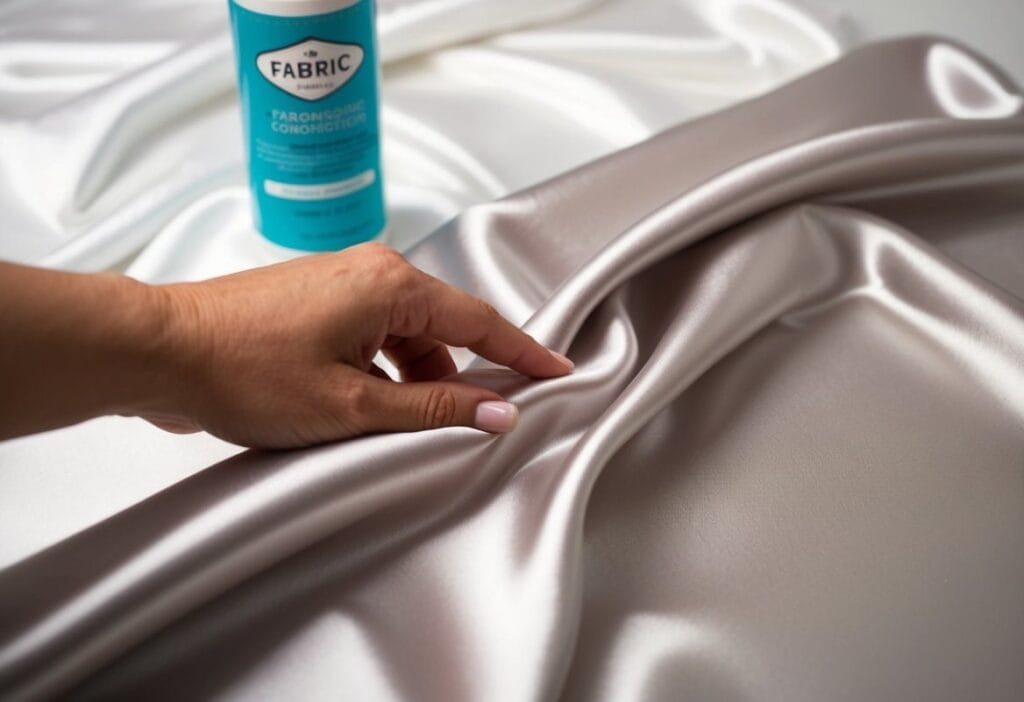
Proper care is essential for keeping satin and silk fabrics looking their best. Both materials require gentle handling and specific cleaning methods to maintain their luxurious qualities.
Maintaining Satin
Satin fabrics need delicate care to preserve their smooth, shiny surface. Always check the care label, as some satin items may be dry clean only. For washable satin:
- Use cool or lukewarm water and a mild detergent.
- Hand wash or use the delicate cycle on your washing machine.
- Avoid wringing or twisting the fabric.
To dry satin, lay it flat on a clean towel. Never tumble dry, as this can damage the fibres. Iron satin on a low heat setting with a pressing cloth to protect the fabric.
Store satin items in a cool, dry place away from direct sunlight. Hang garments on padded hangers to prevent creasing.
Maintaining Silk
Silk requires special attention to maintain its softness and lustre. It’s best to hand wash silk in cool water with a gentle soap made for delicates. Never use bleach or harsh detergents.
After washing:
- Rinse thoroughly in cool water
- Gently squeeze out excess water, don’t wring
- Roll in a clean towel to remove moisture
Hang silk to air dry away from direct heat or sunlight. Iron on a low setting while the fabric is still slightly damp, using a pressing cloth to prevent shine marks.
Silk is naturally hypoallergenic, making it ideal for those with sensitive skin. Store silk items in breathable garment bags to protect from dust and insects.
Durability and Longevity
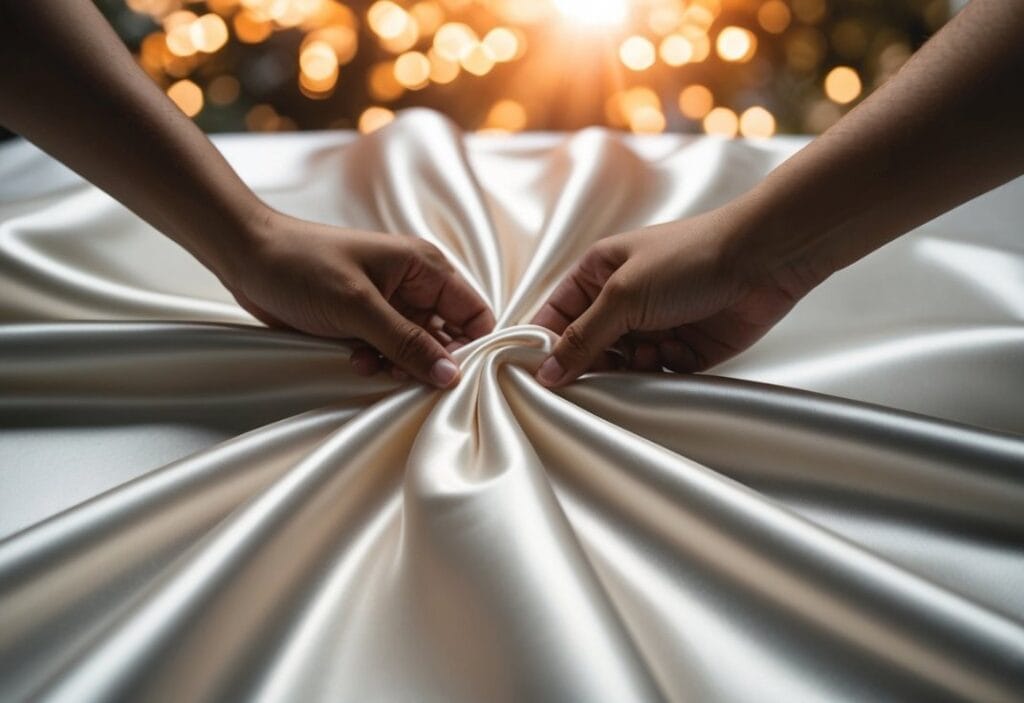
Satin and silk fabrics differ in their ability to withstand wear and tear over time. Both materials have unique properties that affect their lifespan and maintenance needs.
Satin Durability Factors
Satin’s durability depends on its fibre composition. Synthetic satin made from polyester or nylon tends to be quite strong and resistant to wrinkles. These materials can withstand frequent washing and wear without losing their sheen.
Satin is less prone to snagging than silk. This makes it a good choice for everyday items like bedding or clothing. However, lower quality satin may pill or develop a fuzzy surface over time.
To keep satin looking its best:
- Wash in cool water
- Use a gentle detergent
- Avoid harsh chemicals
- Iron on low heat if needed
Silk Longevity Perks
Silk is known for its surprising durability despite its delicate appearance. When cared for properly, silk items can last for years. The natural protein structure of silk fibres gives them strength and resilience.
Silk doesn’t pill like some synthetic fabrics. It retains its softness and lustre even after many uses. Silk’s moisture-wicking properties help it stay fresh and odour-free.
Key maintenance tips for silk:
- Hand wash or dry clean
- Use pH-neutral soap
- Avoid direct sunlight when drying
- Store in a breathable garment bag
While silk requires more careful handling, its longevity often makes it a worthwhile investment compared to synthetic satin alternatives.
Environmental Impact and Sustainability
Satin and silk have different environmental effects due to their production methods and materials used. Both fabrics pose challenges, but their impacts vary in significant ways.
Satin Production
Satin is often made from synthetic fibres like polyester, which come from petroleum. This process uses a lot of energy and creates pollution. Making satin requires harsh chemicals that can harm workers and the environment if not handled properly.
Synthetic satin doesn’t break down easily in nature. It can release tiny plastic bits when washed, adding to water pollution. Some types of satin use rayon, which comes from wood pulp. While more natural, rayon production still needs many chemicals and resources.
Satin factories often use large amounts of water. This can strain local water supplies. The dyes used for satin can also pollute water if not treated well.
Silk’s Environmental Footprint
Silk is a natural fibre from silkworms, making it biodegradable. However, traditional silk production has its own issues. Silkworms are often killed to harvest the silk, raising ethical concerns.
Silk farming, or sericulture, needs mulberry trees for silkworms to eat. This can lead to land use changes. But these trees can also help prevent soil erosion.
Silk processing uses less harsh chemicals than synthetic fabrics. Yet, it still needs water and energy for production and dyeing. Some types, like Eri silk, let the moths live and may be more eco-friendly.
Silk lasts a long time, which can reduce waste. It’s also light, needing less fuel to transport. But silk is costly, which can limit its widespread use as a sustainable option.
Financial Considerations
When comparing silk and satin, cost is a key factor. Silk tends to be pricier due to its labor-intensive production process. The harvesting and spinning of silk from natural cocoons adds to its expense.
Satin, on the other hand, can be more budget-friendly. It’s often made from synthetic fibres like polyester, which are less costly to produce.
Here’s a quick price comparison:
- Silk blouse: £120-£240
- Satin blouse: £40-£80
Both fabrics are considered luxurious, but silk’s higher price tag often positions it as the more premium option.
Availability can also affect cost. Satin is generally more widely available, which can contribute to its lower price point. Silk, being a natural fibre, may have more limited availability.
For those on a tight budget, satin offers a similar look and feel to silk at a fraction of the cost. However, those seeking the unique properties of natural silk may find the higher price justified.
Aesthetics and Styling
Satin and silk both offer unique visual appeal and styling possibilities. Their distinct textures and finishes create different effects in clothing and decor.
Satin’s Elegance
Satin boasts a glossy, smooth surface that catches the light beautifully. Its sheen gives garments a polished, sophisticated look.
Satin works well for evening wear and formal occasions. The fabric drapes elegantly, creating flowing silhouettes.
For home decor, satin adds a touch of luxury to bedding and curtains. Its lustrous finish reflects light, brightening up spaces.
Satin comes in a wide range of colours, from deep jewel tones to soft pastels. This variety allows for versatile styling options.
Silk’s Glamour
Silk possesses a natural sheen that exudes luxury and refinement. Its subtle lustre gives garments a rich, expensive appearance.
The fabric’s light-catching properties make it ideal for special occasion wear. Silk gowns and blouses have a timeless, glamorous quality.
In interiors, silk adds an air of opulence. Silk cushions, throws, and wallcoverings create a sumptuous atmosphere.
Silk takes dye exceptionally well, resulting in vibrant, deep colours. This characteristic allows for stunning prints and patterns.
The fabric’s delicate texture and soft sheen flatter the skin, making it a favourite for lingerie and sleepwear.
Frequently Asked Questions
Satin and silk have distinct qualities that affect hair, skin, and appearance. Their differences in fabric properties, cost, and benefits influence how they are used in clothing and bedding.
What are the differences between satin and silk in terms of their impact on hair?
Silk and satin both offer benefits for hair health. Silk contains natural proteins that can help protect hair, reducing frizz and breakage. Satin’s smooth texture also minimises friction on hair strands.
Silk pillowcases are often recommended for maintaining hairstyles overnight. They help reduce tangles and keep hair moisturised.
How do satin and silk dresses differ in appearance and feel?
Satin and silk dresses have unique looks and textures. Silk dresses often have a subtle sheen and a soft, luxurious feel against the skin.
Satin dresses typically have a more pronounced shine and a sleeker appearance. They can feel cooler to the touch compared to silk.
What distinguishes satin from silk when considering fabric qualities?
Silk is a natural fibre known for its breathability and moisture-wicking properties. It’s hypoallergenic and adapts well to body temperature.
Satin is a weave that can be made from various fibres, including silk, polyester, or nylon. It’s characterised by its glossy surface and smooth texture.
Which is more beneficial for the skin, satin or silk pillowcases?
Silk pillowcases are often considered more beneficial for skin care. They help retain skin moisture and reduce friction, which can prevent wrinkles.
Satin pillowcases also provide a smooth surface for skin, but may not offer the same level of natural benefits as silk.
Between satin silk and mulberry silk, which is considered superior?
Mulberry silk is generally regarded as the highest quality silk. It’s made from silkworms fed exclusively on mulberry leaves, resulting in long, uniform fibres.
Satin silk, if made from silk fibres, can be of high quality but may not match the purity of mulberry silk.
In terms of cost, how do satin and silk typically compare?
Silk is usually more expensive than satin due to its natural origin and labour-intensive production process. High-quality silk items can be quite costly.
Satin, especially when made from synthetic fibres, is often more affordable. This makes it a popular choice for those seeking a luxurious look at a lower price point.
Related Posts:

